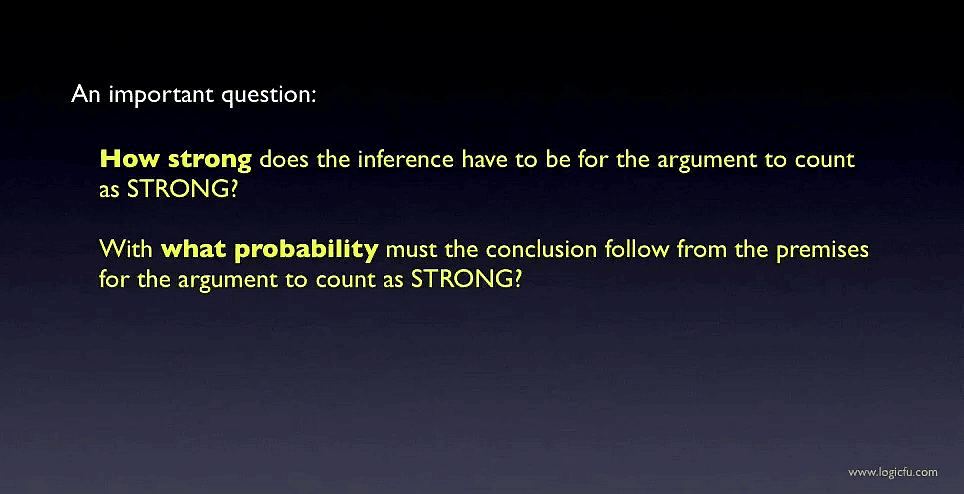Strong & Weak Arguments | Decision Making for UCAT PDF Download
Arguments
An argument is basically a combination of three things:
- Facts/Claims
- Assumptions/Reasons/Evidence
- Conclusion
A proposal is followed by two arguments. An argument may be in favour of or against the proposal. One has to check the strength of the argument. This cannot be misconstrued as considering only favourable arguments. It is irrelevant whether an argument is favourable or adverse to a proposal. Both favourable & adverse arguments are considered provided both of them are strong enough in their own ways.
- The supporting argument normally bases its support on a positive result or a positive feature which would follow, on implementing the course of action proposed in the statement.
- The opposing argument takes its support on the basis of a negative result or a negative feature that follows if the proposed course of action is implemented.

Strength of an argument
An argument is considered to be strong, if it provides a valid & directly related reason either in favour of or against the proposal made.
While considering the arguments, one has to adhere to the following norms:
- The argument is to be considered true, unless it is opposing the generally accepted facts. In other words, the authenticity of the argument cannot be questioned as long as it is not against established facts. For Example- If one argument suggests that Mohamed Ali is stronger than Mike Tyson, we have to take it as true.
- Personal opinion about the proposal shall be ignored. Even if one has an opinion about the proposal, in the discussion it cannot be taken into consideration. In other words, the judgement should always be unbiased.
- Sometimes one may come across a situation in which an argument [say “India should declare war against the whole world”] is absurd. But if it is strong enough in the given context it has to be taken as a strong argument. One cannot deny this argument terming this as absurd.
Important Points to Remember
Ambiguous - The argument should have clarified in the reason suggested in it. The argument should be contextual & express its support or opposition to the given statement in explicit terms.
Example:
Statement- Should India wage war against Pakistan.
Argument- No, both India & Pakistan are at fault.
Analysis:
Here, though the argument refers to the subject in the statement, it has no clarity. We cannot find out what the argument wants to say. Thus, the argument is ambiguous.
Disproportionate - The reasons given in the argument, in support or against the given statement, should be comparable to the magnitude of the situation given in the statement. It should be neither same as “trying to kill an elephant with a needle” nor “trying to kill a mosquito with a sword”.
Example:
- Statement- Should every citizen be asked to use only pencil to write instead of pen?
Argument- Yes, usage of pencil leads to reduction in wastage off paper. This helps in protection of environment.
Analysis:
The argument links usage of pencil to protection of environment, because errors can be rectified on the same paper instead of using a new paper & hence wastage of paper can be reduced. This measure, in practice, makes little difference to the environment; hence, the argument is rejected.
Irrelevant - An argument should relate its reasoning to the context given in the statement.
Example:
- Statement- Should the syllabus for primary classes be reduced, to enable the students to understand the concepts piece meal?
Argument-
1) No, it gives more leisure to students, which may lead to juvenile delinquency.
2) No, the syllabus should include subjects that help in increasing IQ levels of students.
In the given statement, a course of action is suggested to achieve the ultimate aim of enabling students to understand the subjects better. The arguments should base their reasoning as to whether the suggested action results in achievement of the ultimate aim or not. The reason given in argument (1) is out of context when compared to the statement. Hence, this argument is irrelevant.
Argument (2) has relevance to the above statement as it reasons on the same lines as the statement. The statement should include whatever it wants to achieve through the suggested course of action.
Comparative - The argument should suggest why or why not the planned action be implemented, basing on favourable or adverse results that follow after implementation. But it should not support or deny the suggestion, because such action has been taken up or not taken up elsewhere.Example:
Statement: Should India reforms its taxation policy?
Argument:
1) Yes, it helps in rationalization of taxes.
2) Yes, many countries are doing so.
Analysis:-
Argument (1) is a valid argument because it is based on a positive result that would follow the suggested action.
Argument (2) is not based on any resulting effect of the suggested action. It is only comparing with other countries. Others may have their own reasons for taking up such measures. Hence, this is not a valid argument.
Simplistic - These kinds of arguments, though they are related to the statements, make a simple assertion or there is no substantiation to strengthen the argument.
Example:
- Statement: Should India wage war against Pakistan?
- Argument:
- 1) Yes, it should be done immediately.
- 2) No, it is not going to help.
- Analysis:
- Argument (1) simply suggests that it should be done immediately, but does not give any reason as to why it should be done. Hence, this argument is too simple.
- Argument (2) does not show how it is not going to help. Of course, it has shown a reason why such an action should not be taken up, but does not dwell deep into the reason. Hence, the argument (2) is also simplistic.
Example
Ex.1. Should the government invest more in renewable energy sources to reduce dependence on fossil fuels?
Select the strongest argument from the statements below.
(a) Yes, renewable energy sources are sustainable and have a lower impact on the environment.
(b) Yes, investing in renewable energy will create jobs and stimulate economic growth.
(c) No, fossil fuels are more reliable and efficient than renewable energy sources.
(d) No, investing in renewable energy is too expensive and not cost-effective.
Correct Answer is Option (a)
A is correct because it provides a strong reason for investing in renewable energy sources.
B is incorrect because it focuses on economic benefits rather than reducing dependence on fossil fuels.
C is incorrect because it disregards the environmental impact of fossil fuels.
D is incorrect because it focuses on the cost aspect without considering the long-term benefits and sustainability of renewable energy.
Ex.2. Should genetically modified organisms (GMOs) be banned for agricultural use?
Select the strongest argument from the statements below.
(a) Yes, GMOs have unknown long-term effects on human health and the environment.
(b) Yes, banning GMOs will protect organic farming practices and preserve biodiversity.
(c) No, GMOs have the potential to increase crop yields and address global food shortages.
(d) No, banning GMOs would limit scientific advancements and agricultural innovation.
Correct Answer is Option (c)
A is incorrect because it focuses on speculative concerns without concrete evidence.
B is incorrect because it only highlights the benefits of banning GMOs for organic farming, not the overall impact.
C is correct because it presents a strong argument for the potential benefits of GMOs in addressing food shortages.
D is incorrect because it focuses on the negative consequences of banning GMOs without addressing their potential benefits.
Ex.3. Should public transportation be made free to encourage its usage and reduce traffic congestion?
Select the strongest argument from the statements below.
(a) Yes, making public transportation free would incentivize people to choose it over private vehicles.
(b) Yes, reducing traffic congestion would lead to improved air quality and reduced carbon emissions.
(c) No, making public transportation free would lead to overcrowding and insufficient funding.
(d) No, individuals should bear the cost of transportation as it is a personal responsibility.
Correct Answer is Option (b)
A is incorrect because it only focuses on the incentive aspect without addressing the broader impact on traffic congestion.
B is correct because it highlights the potential positive effects of reducing traffic congestion on air quality and carbon emissions.
C is incorrect because it assumes negative consequences without considering potential strategies to address overcrowding and funding.
D is incorrect because it disregards the potential benefits of reducing traffic congestion and promoting sustainable transportation options.
Ex.4. Should school uniforms be mandatory for all students?
Select the strongest argument from the statements below.
(a) Yes, school uniforms promote a sense of belonging and equality among students.
(b) Yes, school uniforms eliminate distractions and promote a focus on academics.
(c) No, school uniforms restrict individual expression and personal style.
(d) No, mandating school uniforms places an additional financial burden on families.
Correct Answer is Option (a)
A is correct because it emphasizes the positive aspects of school uniforms, such as fostering a sense of belonging and equality.
B is incorrect because it focuses on the academic benefits without considering potential drawbacks or alternative solutions.
C is incorrect because it highlights the negative aspects of school uniforms without considering their potential advantages.
D is incorrect because it focuses on the financial burden without addressing the potential benefits of school uniforms in creating a uniform environment.
Ex.5. Should the use of animals in scientific research be abolished?
Select the strongest argument from the statements below.
(a) Yes, animals have rights and should not be subjected to unnecessary harm for human benefit.
(b) Yes, alternative methods such as computer simulations and cell cultures can provide reliable data.
(c) No, animal testing has led to significant medical advancements and improved human health.
(d) No, animals do not possess the same level of consciousness as humans and can be used for scientific purposes.
Correct Answer is Option (c)
A is incorrect because it focuses on animal rights without considering the potential benefits of scientific research.
B is incorrect because it presents an alternative method but does not address the overall effectiveness and necessity of animal testing.
C is correct because it highlights the positive outcomes of animal testing in terms of medical advancements and human health.
D is incorrect because it relies on the assumption that animals' consciousness is different from humans and can be exploited for scientific purposes.
|
16 videos|21 docs|27 tests
|
















